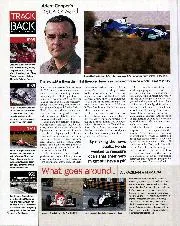
What goes around...
A Brazilian wins Macau Bruno Senna may have fallen well short of emulating his uncle Ayrton’s 1983 win in the Macau Grand Prix - he shunted out on the second…

My idea was that the car would travel the locale, delivering essential supplies and medicines to the vulnerable and, I can’t deny, helping its driver stay sane. I threatened one of Bentley’s press officers with painting a red cross on its roof. But it never happened. I am a registered NHS responder but the call never came. My beautiful Bentley has just sat there. I’ve used it to help resupply the isolated in-laws a few times and once to pick up the fish order for our village shop. Then a feeling I thought I’d parked started to resurface…
I first had it when I owned an Aston Martin DB2/4 MkIII about 25 years ago. It was a lovely car but like so many fools who’ve bought an old Aston in the past, I saw only that I could afford to buy it and had not thought about running it. Feltham Astons aren’t cheap, even if they’re in the finest fettle, and mine was not. So I stopped using it. It sat in the shed and every time I opened the door, what I felt upon seeing it was not pride or joy, but guilt. Guilt about failing to practice what I preached, guilt about the amount of money it represented, guilt about how much it had already cost and over how few miles that cost had been amortised, and guilt that I was denying someone the chance to cherish and use it.
I was delighted when I finally sold it for a humiliating sum to a charming German businessman who turned up at my cottage in Wales and drove to Germany, via an overnight stay in Dover, and blew it up doing 120mph on the autobahn. I felt guilty about that too.
If I learned my lesson that day, it did not stay learned for long. The next car down the line was a gorgeous 993-series Porsche 911 Carrera RS I bought from Nick Faure. ‘Aha,’ I thought, ‘it will never go wrong, so I won’t be afraid to use it, so I’ll enjoy having it.’ And, true, it never went wrong, but I still ended up not using it, this time because I’d just gone freelance and spent every working hour driving test cars to earn a living. I will never forget finally getting back into it one bright morning in early spring and discovering the clock still set to summer time. I sold that too.
Having the Bentley has been like havinga wonderful bottle of wine, uncorked and ready to go and someone saying you can only sniff. I appreciate that no reader will be wiping a tear from their eye at my plight, but it does remind me of the most important consideration when it comes to buying a car. What are you going to do with it? If the answer to that doesn’t come freely and honestly, stay away. Take it from someone who knows.
I was rifling through some photographs the other day and stumbled across some shots I took in May 2012, when with a few others, I took Sir Stirling Moss and Norman Dewis back to Brescia to celebrate the 60th anniversary of their drive for Jaguar in the 1952 Mille Miglia.
It brought the memories flooding back: Stirling hesitant on camera, hilarious in private, Norman always in his element. Even then, they were the oldest surviving team of any note to have done the original race. It’s awful to think we’ve lost both in the last 12 months.
My fondest recollection of that weekend is seeing the two of them greet each other in the lobby of the Ca’ Nöa hotel in Brescia. I don’t know how long it had been since they last met but this wasn’t just the reunion of two old mates, there was something deeper too, maybe the experience they shared which no other person present could have understood.
They’d taken not just any C-type, but XKC003 – the car that the previous year had taken Jaguar’s first Le Mans victory – and, with only a skeleton crew, had driven it to Italy to do the Mille Miglia. They’d done it not as a full-works entry intent on victory, but to put new technology through the toughest test. Back then they were called ‘plate brakes’ but we know them as discs. They raced not knowing if or when brake failure might occur, nor the possible consequences. They managed 827 miles and were third when the car cried enough. But it was the steering, not the brakes, that quit. Those plates had behaved perfectly.
We couldn’t provide XKC003 in 2012 – it had been scrapped in period by the factory – but XKC005 was the best substitute as the first car ever to win a race with disc brakes, at Reims in 1952 with, appropriately, Stirling driving. I tend not to struggle with my emotions when working, but I wasn’t the only one with a lump in my throat when Stirling guided the C onto the starting ramp.
They didn’t take part in the retrospective, but parked the car around the corner and went back to the hotel where we all drank too much. When it was just Norman and I left in the bar, he started talking, only in general terms, about his other life as a turret gunner in the appallingly vulnerable Bristol Blenheim bomber during the war.
My only regret is that the film of Stirling and Norman’s grand reunion never saw the light of day. I’m not sure why, but it’s out there somewhere. How good it would be to celebrate their lives with its airing.